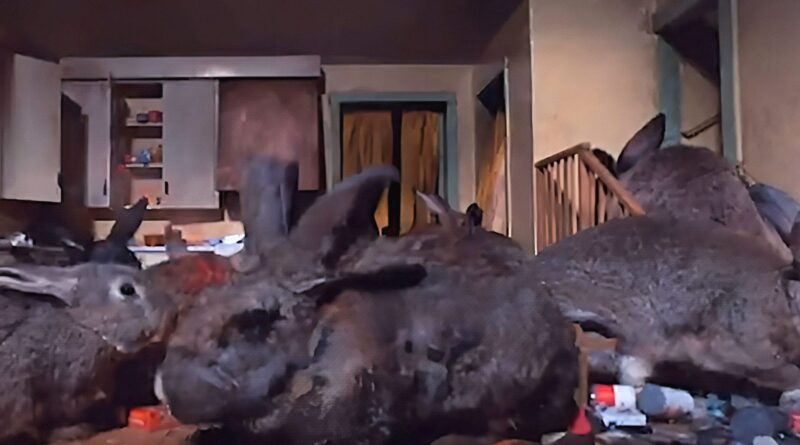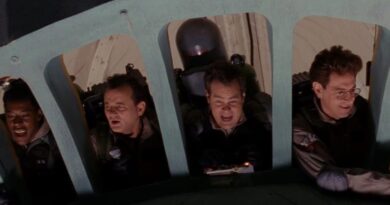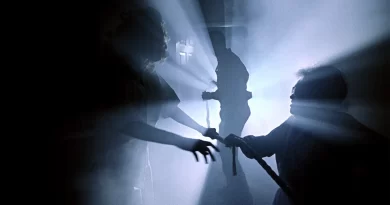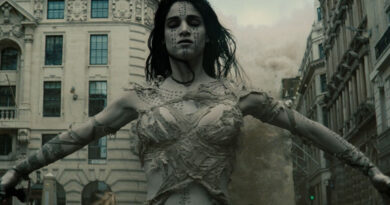Night of the Lepus (1972)
Just when I think filmmakers have at last scraped the bottom of the barrel for a horror story, along comes a movie that proves the bottom still hasn’t been reached. This time, it’s called Night of the Lepus, and it tells the story of giant mutated rabbits terrorizing a tiny, middle-of-nowhere Arizona desert town. So high-concept is this film, the last sentence I wrote was a detailed description, not just a boilerplate synopsis. Movies like this, with their shabby desperate-for-a-plot sensibilities, often develop cult followings; I wouldn’t be surprised if this film finds its way into midnight movie houses, where devoted audiences will convene regularly to laugh in all the wrong places and hurl insults at the screen.
The opening credits inform us that it’s based on Russell Braddon’s novel The Year of the Angry Rabbit, an absurdist anti-war dark comedy in which the mutated rabbits are but one fraction of a satirical whole that addresses biological warfare, capitalism, and nationalism, specifically in regards to Australia, Braddon’s homeland. It was essentially a cross between Dr. Strangelove and Tarantula. With Night of the Lepus, all political and social undercurrents are ignored, and although it’s a laugh riot, the intention was obviously not to be funny; the giant rabbits, once having narrative subtext, are now nothing more than monsters in a gory creature feature. Did the filmmakers really believe this could be taken at face value, that it would truly frighten anyone, that it wouldn’t make audiences laugh?
What makes this all the more frustrating is that the film begins on notes that gave me the tiniest glimmers of hope. We open with an expository news report by none other than Southern California’s own Jerry Dunphy, who explains, with surprising accuracy, the detrimental effects of introducing an animal to a habitat it’s not suited for; in real life, the rabbit’s introduction to Australia in 1788 allowed for not just an evolution, but also a crop-destroying infestation which continues to this day. But as soon as that opening scene ends, it’s a long, fast downhill fall, and it takes with it some notable names, including Stuart Whitman, Janet Leigh, Rory Calhoun, and even DeForest Kelley, Dr. Leonard “Bones” McCoy himself.
The plot, such as it is, sees a husband-and-wife animal research team (Whitman and Leigh) looking for a poison-free way to control a rabbit population ruining the land of an Arizona rancher (Calhoun). The one lab rabbit injected with hormones – done, I think, with the intention of messing with its ability to reproduce – has an unforeseen side effect: It makes the rabbit grow in size. Naturally, it escapes back into the wild, allowing for the immediate breeding of giant killer rabbits that eat people and horses. So it seems this hormone injection has another side effect the film doesn’t bother to address, namely changing rabbits from herbivores to carnivores. One simple line of dialogue wouldn’t have added credibility, but it would have been enough to acknowledge this narrative choice: “My God, they eat meat now!”
There are multiple reasons why the film fails, and they’re all very common: The basic premise is ridiculous; the dialogue is amateurish; the actors seem to have forgotten they were cast in a horror movie and thus make very little effort to seem desperate, urgent, or frightened. And then there are the special effects, which follow in the tradition of most monster movies, especially those of the Atomic Age, by shooting fluffles of real rabbits at a higher frame rate as they run down miniature streets and house sets. As cheap and unconvincing as those shots are, they don’t hold a candle to the hilariously inept shots of rabbits attacking people, in which it’s glaringly obvious that those “rabbits” are just stuntmen in rabbit costumes.
If I had to narrow the film’s failure down to just one fundamental flaw, it would be that rabbits are simply not frightening animals, and nothing the filmmakers do make them so. Even with extreme closeups of rabbits barring their teeth, even with their grotesque proportions, even when stage blood is smeared on their faces, the rabbits always look fluffy and cute. All monster movies involving large versions of real animals are ridiculous. But at least most of them showcase creatures that are definitely not cute and genuinely terrifying when cinematically enlarged, like gila monsters, komodo dragons, and various insects and arachnids. If Night of the Lepus is of any indication, then a sad new chapter of the monster movie has begun; audiences are now expected to be terrified by the adorable. What’s next? Attack of the Giant Gerbils? Revenge of the Killer Hamsters?




